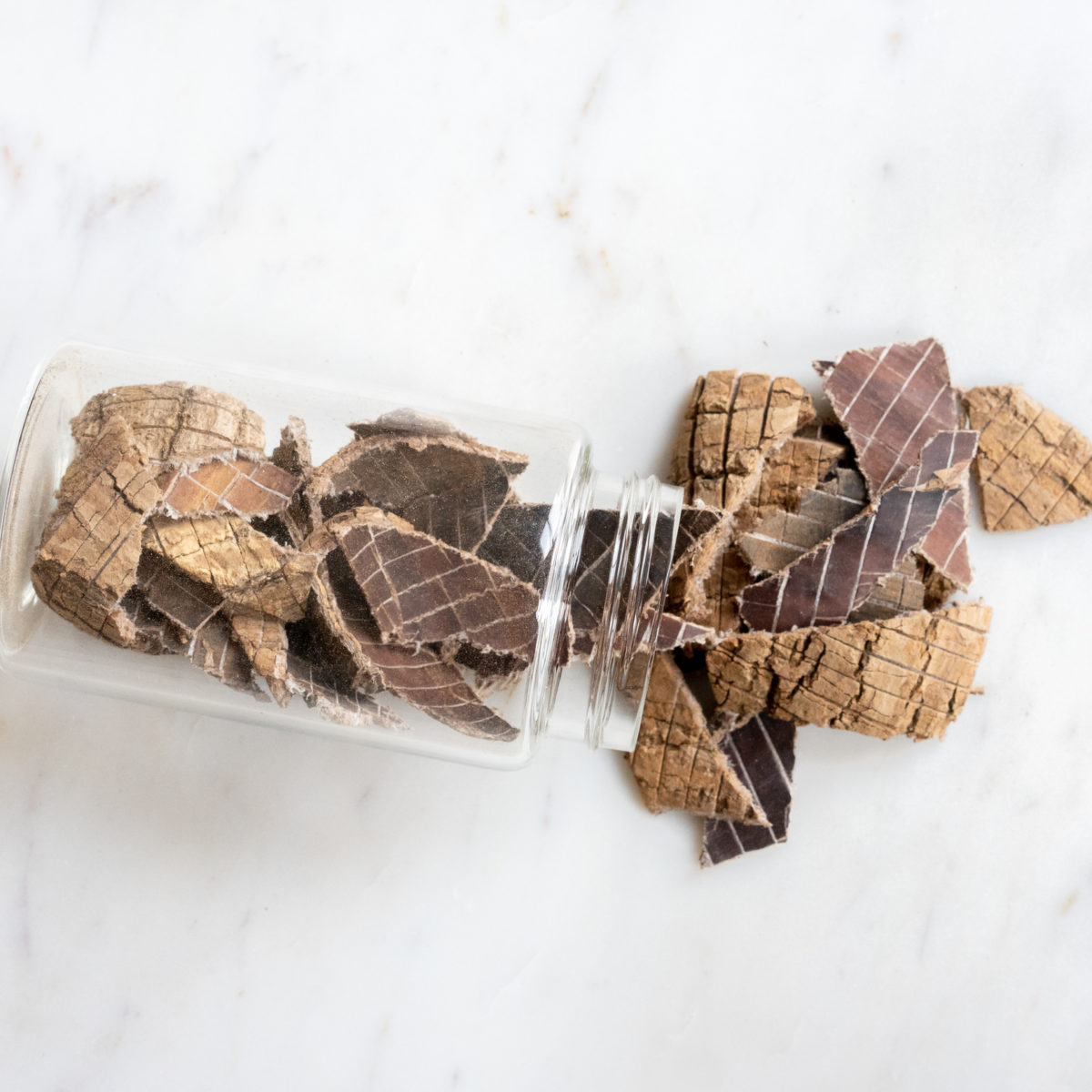
COMMON NAME (Chinese Name)
Eucommia Bark; Hardy Rubber Tree (Dù Zhòng)
BOTANICAL NAME
Eucommia Ulmoides
USES
Eucommia is the stem bark of the hardy rubber tree, striated and dried so that the pharmacologically active latex can be accessed. Eucommia bark has well-known, empirically and anecdotally supported anti-inflammatory, anti-allergenic, antimicrobial, and anti-aging effects. What’s more, these supplements have a long history of traditional use in the treatment of inflammatory and stress-induced cardiovascular conditions as well as sexual dysfunction, osteoporosis, and some painful neuropathies. Both leaf- and bark-based extracts have found uses in each of these areas, though the bark is perhaps better known for its effects on bone health, as it may help increase bone density, speed fracture healing, and stave off osteoporosis. What’s more, these extracts may specifically help post-menopausal women and women who have had hysterectomies better retain bone density.
In Chinese medicine the bark is classified as an herb that tonifies yang, warming up cold people and improving metabolism. It is categorized as warm, sweet and acrid and especially affects the Kidney and Liver meridians. The herb is usually prescribed dry-fried to stop dysfunctional uterine bleeding and menstrual difficulties. It is also salt-fried for hypertension. It is commonly used in China to prevent miscarriage.
In addition to these traditional uses, Eucommia bark leaf extracts have found new uses for reducing hyperglycemia (high blood sugar) and for its anti-aging effects. Likewise, Eucommia bark bark extracts are finding more contemporary applications, with recent studies supporting the idea that its oral use may protect cartilage from degradation and help speed recovery from cartilage injuries. Topical application of Eucommia bark extract (whether bark or leaf is unspecified) may help reduce the appearance and severity of acne.
PREPARATION & ADMINISTRATION
The bark is generally dry-fried or salt-fried before decoction, depending on the effect desired. Though much traditional literature on Eucommia bark supplements focuses only on using the bark, more recent studies also include research into Eucommia bark leaf supplements. Hot water decoctions are among the most popular methods for preparing Eucommia leaf and bark extracts, though much of the current body of research also tests the efficacy of alcohol-based and multi-step extraction. Consequently, depending on your goals for taking Eucommia supplements, you may want to purchase formulas as defined by a TCM practitioner than whole, dried bark or leaves, powders, or pills.
PRECAUTIONS
Like any supplement that may impact blood sugar levels, people with hypoglycemia, diabetes, and/or who are already taking blood-sugar-lowering medications should exercise caution when taking Eucommia bark supplements.
You should consult with a certified herbalist, physician or other qualified healthcare professional before taking Eucommia.
REFERENCES
Chen, John, Chen, T & Cramton, L. Art of Medicine Press, Inc. City of Industry, CA USA. 2003. 1327 pp ISBN: 0-9740635-0-9 , http://aompress.com/herbology
Cheng, Chi-Fung, et al. “Effects of Chinese Herbal Medicines on the Risk of Overall Mortality, Readmission, and Reoperation in Hip Fracture Patients.” Frontiers in Pharmacology, vol. 10, Nov. 2019, doi:10.3389/fphar.2019.00629.
Cheng, Juei-Tang, et al. “Eucommia Bark (Du-Zhong) Improves Diabetic Nephropathy without Altering Blood Glucose in Type 1-like Diabetic Rats.” Drug Design, Development and Therapy, 2016, p. 971., doi:10.2147/dddt.s98558.
Fox, Lizelle, et al. “Treatment Modalities for Acne.” Molecules, vol. 21, no. 8, 2016, p. 1063., doi:10.3390/molecules21081063.
Fu, Hui, et al. “Eucommia Ulmoides Oliv. Leaf Extract Improves Erectile Dysfunction in Streptozotocin-Induced Diabetic Rats by Protecting Endothelial Function and Ameliorating Hypothalamic-Pituitary-Gonadal Axis Function.” Evidence-Based Complementary and Alternative Medicine, vol. 2019, 2019, pp. 1–12., doi:10.1155/2019/1782953.
Galanis, Dimitrios, et al. “Protective Effect of Glycyrrhiza Glabra Roots Extract on Bone Mineral Density of Ovariectomized Rats.” BioMedicine, vol. 9, no. 2, 2019, p. 8., doi:10.1051/bmdcn/2019090208.
Hussain, et al. “Health-Promoting Properties of Eucommia Ulmoides: A Review.” Evidence Based Complimentary Alternative Medicine, 2016.
Lee, Mi-Kyung, et al. “Hypoglycemic Effect of Du-Zhong (Eucommia Ulmoides Oliv.) Leaves in Streptozotocin-Induced Diabetic Rats.” Diabetes Research and Clinical Practice, vol. 67, no. 1, 2005, pp. 22–28., doi:10.1016/j.diabres.2004.05.013.
Lu, Hai, et al. “Effects of an Aqueous Extract of Eucommia on Articular Cartilage in a Rat Model of Osteoarthritis of the Knee.” Experimental and Therapeutic Medicine, vol. 6, no. 3, 2013, pp. 684–688., doi:10.3892/etm.2013.1223.
Sasaki, Yūf., et al. “Antimutagenicity of Tochu Tea (an Aqueous Extract of Eucommia Ulmoides Leaves): 2. Suppressing Effect of Tochu Tea on the Urine Mutagenicity after Ingestion of Raw Fish and Cooked Beef.” Mutation Research/Genetic Toxicology, vol. 371, no. 3-4, 1996, pp. 203–214., doi:10.1016/s0165-1218(96)90108-1.
Tu, X., Huang, G., & Tan, S. (2009). Chinese Herbal Medicine for Dysfunctional Uterine Bleeding: a Meta-analysis. Evidence-based complementary and alternative medicine : eCAM, 6(1), 99–105. https://doi.org/10.1093/ecam/nem063
Zhu, Ming-Qiang, et al. “Isolation and Analysis of Four Constituents from Barks and Leaves of Eucommia Ulmoides Oliver by a Multi-Step Process.” Industrial Crops and Products, vol. 83, 2016, pp. 124–132., doi:10.1016/j.indcrop.2015.12.049.
